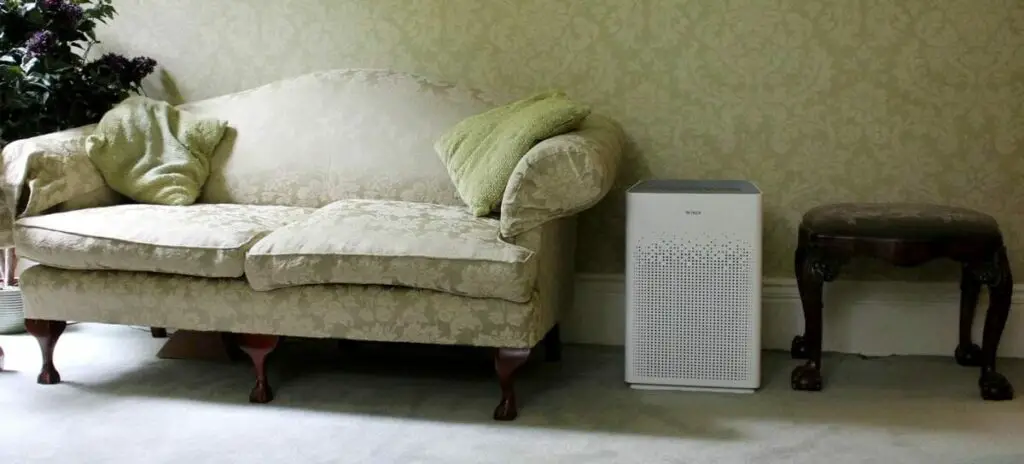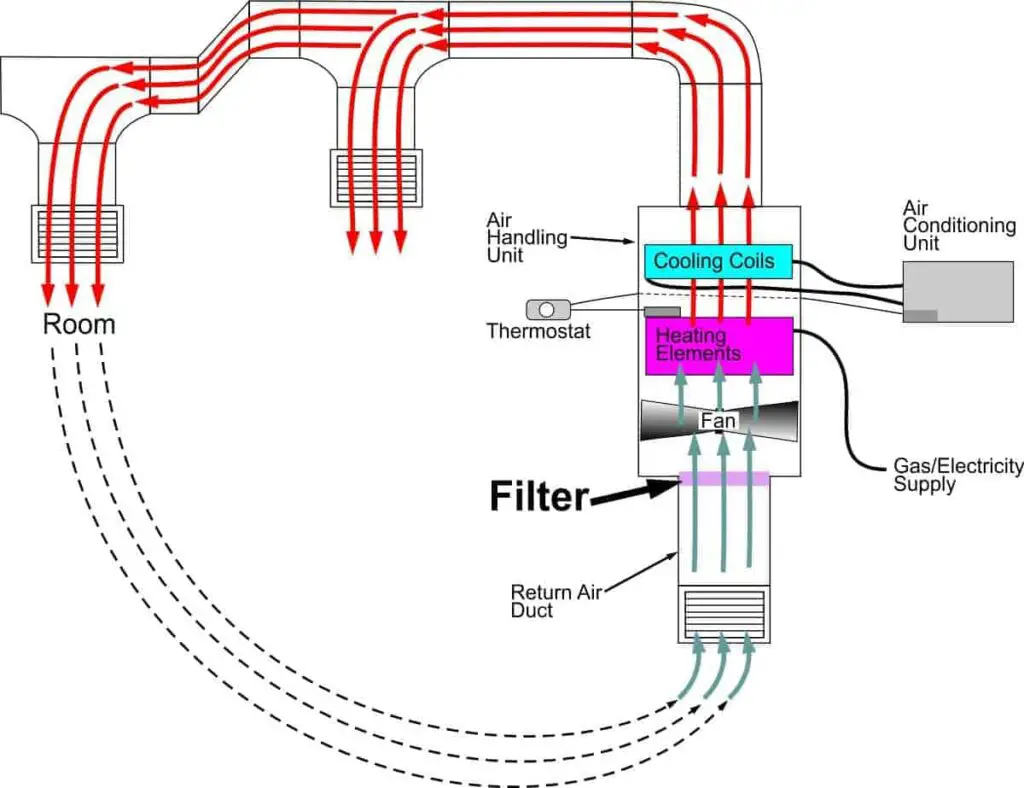Air purifiers are essentially consist of a fan pushing air through a true HEPA filter in an enclosure. So it is quite right to ask why are air purifiers so expensive? Obviously, the fan, motor and the control circuitry is relatively cheap to manufacture. Although there is quite a lot of research and development that goes into the aerodynamics of the fan to lessen the noise it makes. However, the really important technology is in the HEPA filter. This has to reliably capture particles that are only slightly larger than molecules. Otherwise, they will end up in our lungs and the smaller ones penetrate the lung tissue, enter our bloodstreams and reach our internal organs. These ultrafine particles can even reach our brains directly through a nerve in our noses!
On the whole air purifiers are expensive because unlike other home appliances they have a healthcare function. There is solid evidence the higher the particle concentration in the air, the greater the risk of dementia, heart attacks and strokes and a long list of other health problems.
As they serve a healthcare purpose then people are willing to pay more for them and marketing plays into this.
Are the Health Benefits Enough to Justify Buying an Expensive Air Purifier?
Airborne particles have been shown in clinical or epidemiological studies, often multiple studies, to cause-
- Coronary heart disease-heart attacks
- Strokes
- Premature aging of the lungs
- Chronic obstructive pulmonary disease
- Pneumonia
- Cancer
- Lymphoma
- Diabetes
- Skin problems including skin aging
- Autoimmunity
- Osteoporosis
- Diabetes
- Kidney disease
- Dermentia
- Cognitive decline-decrease in thinking ability
- Parkinson’s disease
- Vision impairment-age related macular degeneration and glaucoma
- Impairment of sense of smell
- Sleep disturbance
- Depression
- Anxiety
- Increased risk of psychiatric problems
- Decrease in fertility
- Increased miscarriage
- Exposure during pregnancy linked to neurological problems, asthma, lower IQ in child
- Children-lower intelligence and delayed psychomotor development, faster decline in cognitive function in adulthood
- Children-chest infection, asthma
- Children-increased obesity
- Children-increased psychiatric problems
- Children-death rate increased
- Premature aging?-ultrafine particles speed up several processes involve in aging
- Premature death
So this is an impressive list of health problems but at what airborne particle count do health effects occur, and are they likely to affect me?
Although it is not well known, the studies of the impact of fine airborne particles, PM 2.5, on human health are looking more and more serious. For instance, heart attacks and strokes, are seen at even low levels within the EPA safe range. A similar finding of increasing risk of dying with fine particle exposure even at low levels was found in a study of 652 cities. These findings were published in the world’s top cardiac journal Circulation and top medical journal The New England Journal of Medicine.
There has since been additional studies showing the increase in mortality at low PM2.5 airborne particle counts.
A study from Europe, also showing increased mortality at airborne particle counts under the EPA’s limit.
A study from Harvard looked at the effect of low levels of air pollution, PM 2.5 less than 12 µg/m3 on mortality. All patients aged at least 65 years enrolled in Medicare from 2000 to the end of 2016 were studied, so more than 50 million people. It was found even within this of range particle concentrations, considered to be safe, that annual mortality increased 0.073% for each 1 mcg/m³ increase in PM 2.5. So a decrease in PM 2.5 particle count of 10ug/m3 would reduce absolute mortality by 0.73% which for this population represents a percentage mortality reduction of approximately 14%. This is easily achievable with an air purifier.
For those over 85 years old the risk was approximately 7 times as great as for those between 64 and 75 years old. So this study also showed that the elderly are a vulnerable group, and so have more to gain from airborne particle reduction with an air purifier.
A recent study from Canada, which looked at changes in long-term residential exposure to particulate matter PM 2.5 and found when people move from one area of the country to another which had a different pollution level. The people who moved from a high pollution area to a low pollution area went from an average PM 2.5 level 10.6 mcg/m³ to 5 mcg/m³. The people that went from a low pollution area to a high pollution area increased their PM 2.5 from 4.6 mcg/m³ to 9.2 mcg/m³. Over 5 years those people who moved from high to low levels of PM 2.5 pollution had a 6.8% reduction in mortality, mainly from cardiovascular causes and diabetes. Conversely those people who moved from a low to higher-level pollution had an increase in mortality, particularly from respiratory disease.
So here we have a study which directly suggests that lowering PM 2.5 levels in humans leads to lower mortality.
The World Health Organization has now lowered the safe limit for PM 2.5 fine airborne particles to 5 mcg/m³.
According to EPA statistics, covering 200 million people in the US, 98% of US citizens are living in areas with PM 2.5 concentrations above the new WHO guidelines. These statistics are flattering to outdoor air particle count as they were collected during the COVID epidemic, when activity both industrial and vehicular was reduced, so the real picture with a fully functioning economy may be even worse. In addition the situation is actually worse than these outdoor measurements, as indoor air pollution is often worse than outdoor air pollution, for instance when we cook or even make toast particle count in our homes increases dramatically above the background level. Moreover, even these WHO guidelines seem to be aiming for particle count that is higher than those leading to the lowest mortality rates, please see the graph below-

This is based on data from the first 2 studies referenced above.
The percentage reduction in mortality from using an air purifier may seem to be small. However-
- This is an average and particularly vulnerable adults may have more to gain. The Harvard study mentioned above only considered people older than 64 who were medicare enrolees and found an effect that was double that in the graph above.
- Also death is obviously an enormously significant endpoint, but there are a whole range of disease and disability short of actual death that is caused by airborne particles.
- Even using the EPA’s air quality standard of 12 ug/m3, about a million years of American’s lives are lost each year due to air pollution so the scale of the problem is huge. If we now consider anything above 5 ug/m3 as abnormal the problem is many fold greater as so many more people are affected by being considered to live in a polluted area and the potential increase in numbers dying considered to be due to air pollution will be much greater.
So if we choose to use air purifiers to alter our airborne particle count, and if we use them properly we should be able to reduce the particle count to under 1 mcg/m3. The graph shows that the lower the PM 2.5 particle count the greater the reduction in mortality per unit of PM2.5 reduction.
However, the really important observation is that these effects are apparent at levels of particles in the air that we think of as “normal”, well below the limits at which “pollution” starts. So we may need to change our attitudes away from only those in polluted areas needing air purifiers, towards the possiblility of everyone potentially benefiting from breathing purified air for at least part of their day.
Here you can find further details on the health effects of air pollution.
So as a general rule the potential health benefits are worth buying an air purifier that you can have confidence will meet the minimum at least 80% reduction in particle count that the EPA recommend.
Are all air purifiers expensive?
Air purifiers are not all expensive. For instance, there is a true HEPA air purifier from an established American manufacturer that is less than $80. It is the Levoit 200S, and gives more airflow per dollar, and reasonable noise level, than any other air purifier on the market. So it is possible to get a cheap air purifier that is good. However, it is only suitable for daytime rooms up to 183 sq ft or bedrooms up to 85 sq ft unless you are pretty noise tolerant (assuming 8ft ceilings). Please see the image below –

So it really depends on what special features you want from your air cleaner as to how much you will need to pay to purify your indoor air quality.
A fibrous filter using HEPA technology or equivalent specification is essential in a portable air purifier for removing particulate matter, which is the most important indoor air pollution, from the air. UV light will not make a significant difference to particle count and other technologies do significantly less well than HEPA filtration. You should be careful not to buy an air purifier that emits ozone. The downside to HEPA filtration is that filter replacement is needed which is an ongoing cost. I have written a helpful article about buying an air purifier.
All true HEPA filters will remove most fine airborne particles including-
- House dust mite
- Pet dander
- Pollen
- Mold Spores
- Dust-household and atmospheric
- Bacteria
- Viruses
- Brake dust
- Tire dust
- Vehicle exhaust particles
- Smoke particles both cigarette and wildfire
Also the air purifier may last for 5-10years so the initial cost of the actual machine is spread out over several years.
Unfortunately although you should definitely look into upgrading your air conditioner/HVAC filter, you will probably not be able to reach HEPA specification. Here are in depth articles on upgrading the HVAC filter and using your HVAC system as a whole home air purifier.
So you will still need to buy air purifiers.
Are expensive air purifiers worth it?
This is for everyone to decide depending on the amount of money that they have. There are some advantages to more expensive air purifiers-
Expensive Air Purifiers Can Be Quieter
Some air purifiers can be less than half as noisy for the same airflow. There are 2 ways that this is achieved-
- Increasing surface area the filters so that the airflow can be slower and yet still filter an adequate amount of air. This is the strategy taken by Coway in the 400S and 300S models.
- Using a specially designed motor and fan combination, this is the strategy used by Oransi for its EJ120 air purifier.
Here is a helpful article about the quietest possible air purifier. Here is the Coway 400S one of the quietest air purifiers-

Because these air purifiers are the quietest per unit air flow on the market, it is understandable that they sell for a premium.
Expensive Air Purifiers Can Provide Air Purification to Large Rooms
Cheap air purifiers are not usually able to adequately purify the air in large rooms. More expensive air purifiers are needed for this as outlined in this article “Best air purifier for a large room“.
Some Air Purifiers Are Specified to Remove Ultrafine Particles
The vast majority of air purifiers use HEPA filters, true HEPA filters are specified to filter out particles 0.3 micrometres 99.97% efficiency. However, there is no specification regarding ultrafine particles. There are some air purifiers are specified by the manufacturers to filter out ultrafine particles. That is particles less than 0.1 micrometres in diameter. These are particularly injurious to human health, particularly provoking heart attacks. They may also speed up aging.So, as there is more certainty about the protection of your health, it is logical to pay more for these air purifiersThere is a helpful article about ultrafine particles here.
A Few Air purifiers Have a Special Ability to Remove Chemicals-this protects health during wildfires
There are some air purifiers that have large activated carbon filters and so the capacity to remove large amounts of chemicals, particularly volatile organic compounds, from the air. These compounds make wildfire and cigarette smoke much more dangerous than just the airborne particles alone.
Examples are the iQair MultiGas, and iQair HealthPro Plus. Below is a table of various air purifiers with the amount of activated carbon in the filter.

| Chemical Removing Capacity of These Air Purifiers | Amount of Activated Carbon in Filter |
| iQair Multigas | 12lb |
| iQair HealthPro Plus | 5lb |
| Orsani EJ120 | 3.5lb* or 1lb |
| Coway 400S | 1.5lb |
| Levoit 250 | 0.1lb |
This type of air purifier is very uncommon and as it is dealing with important health aspects, some people may be happy to buy a relatively expensive air purifier.
The Removal of Odor From Your Home is Better With Some Air Purifiers
Air purifiers that are particularly good at removing chemicals from the air in the above section will also do a great job of removing odors from your home. Of course, the main thing is to remove the source of the odor and if this is possible, then to remove it. Nonetheless, air purifiers will make an enormous difference.
Removing odors as it is not health critical, you could buy cheaper air purifiers than the ones above. You should look for granular activated carbon filters that have an above average amount of activated carbon in the filter. Some air purifiers simply have a fibrous filter that is sprayed or dipped in activated carbon and so has relatively little activated carbon in the filter.

Is an air purifier a waste of money?
As a general rule, an air purifier used properly will lower your particle count by 80% and so the number of particles that settle in your lungs and enter your bloodstream. Long term, this is likely to improve your health. This article outlines the health effects of particles in some detail.
An air purifier can become a waste of money if you do not use it appropriately. The most common problem is turning the fan speed down to reduce the noise. If you sized it to your room when you brought it for the higher fan speed, this will make its air purification substandard. The particle count that you will then breathe in will be higher than it should be, and the evidence suggests that your mortality will also be higher.
Both buying an appropriate air purifier for your room and using it properly are quite difficult. Here is a helpful article about buying an air purifier. There is an in-depth article about how to use an air purifier here. The most important aspect of using an air purifier is measuring the air quality before during the air purifier is running to check that there is at least an 80% reduction in particle count as recommended by the EPA. There is an article about buying an air quality meter, some can be as cheap as $25.
Why are some air purifiers expensive?
On the whole this seems largely to be due to marketing. There will of course, be different research and development, manufacturing and quality control costs, but these do not seem to account for the tenfold variation in cost of the machines. The reason this situation persists is that the consumer cannot see the air particles being removed and so does not know how well different machines work. So in this absence of solid information, the marketing departments have a field day persuading the consumer. If every consumer brought a particle counter and posted reviews, the difference in price would narrow dramatically for most machines. However, there are some technologically superior machines that people will always be happy to pay a premium for-those that give superior ultrafine particle and chemical removal and those that are ultra quiet.
The technology in some air purifiers is definitely better than that of others. Some air purifier companies will have higher research and development costs than others. A few air purifier companies have higher quality control standards and even send their air purifiers out with individually measured airflows on each fan setting.
To protect yourself against buying an expensive but ineffective air purifier you may wish to read this article-Buying an Air Purifier-Don’t Make a Mistake Like I Did.
Conclusion
So are air purifiers expensive? Not all air purifiers are expensive, they start at under $80. The filters protect health and so need to be expertly designed and manufactured. These filters remove both particles and chemicals from the air. Given the health benefits, most air purifiers are reasonably priced.There are some exceptions that are too expensive and not really very good. This is not obvious from the marketing and see you need to be careful when you buy an air purifier.
Related Questions
Related Posts
How to Test Air Quality in Your Home-air quality meters from $35

Make a dream “Whole Home Air Purifier” from an HVAC System?


